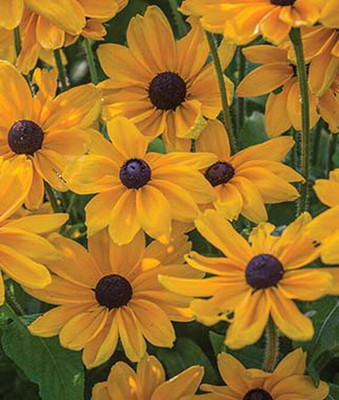VibeX Rudbeckia Seed(50 per packet)
Quick Overview
Product Price Comparison
Enormous single and semi-double golden blossoms 6-9" across.This All-America Selections winner with its huge blossoms and vigorous, uniform plants adds bold, eye-catching color to borders and beds. GARDEN HINTS: In mild climates, sow seeds outdoors 1/4" deep any time of the year..How to Sow and PlantRudbeckia may be grown from seed sown early indoors or planted as a potted plant.Sowing Seed Indoors:Sow indoors 10 weeks before last spring frost using a seed starting kitSow seeds ┬╝ inch deep in seed-starting formulaKeep the soil moist at 70-75 degrees FSeedlings emerge in approximately 21 daysAs soon as seedlings emerge, provide plenty of light on a sunny windowsill or grow seedlings 3-4 inches beneath fluorescent plant lights turned on 16 hours per day, off for 8 hours at night. Raise the lights as the plants grow taller. Incandescent bulbs will not work for this process because they will get too hot. Most plants require a dark period to grow, do not leave lights on for 24 hours.Seedlings do not need much fertilizer, feed when they are 3-4 weeks old using a starter solution (half strength of a complete indoor houseplant food) according to manufacturerŌĆÖs directions.If you are growing in small cells, you may need to transplant the seedlings to 3 or 4 inch pots when seedlings have at least 2 pairs of true leaves before transplanting to the garden so they have enough room to develop strong roots.Before planting in the garden, seedling plants need to be ŌĆ£hardened offŌĆØ. Accustom young plants to outdoor conditions by moving them to a sheltered place outside for a week. Be sure to protect them from wind and hot sun at first. If frost threatens at night, cover or bring containers indoors, then take them out again in the morning. This hardening off process toughens the plantŌĆÖs cell structure and reduces transplant shock and scalding.Sowing Directly in the Garden:In mild climates, sow seeds outdoors at any time of the year.Remove weeds and work organic matter into the top 6-8 inches of soil; then level and smooth.Sow seeds evenly and cover with ┬╝ inches of fine soil.Firm the soil lightly and keep it evenly moist.Seedlings will emerge in about 21 days.Planting in the Garden:Select a location in full sun with good rich moist organic soil.Prepare the bed by turning the soil under to a depth of 6-12, inches removing any debris, and lightly raking as level as possible.The addition of organic matter (leaf mold, compost, well-rotted manure) benefits all gardens and is essential in recently constructed neighborhoods.Plant on a cloudy day or in late afternoon to reduce transplant shock.Dig a hole for each plant large enough to amply accommodate the root ball.Unpot the plant and gently loosen the root ball with your hands to encourage good root growth.Place the top of the root ball even with the level of the surrounding soil. Fill with soil to the top of the root ball. Press soil down firmly with your hand.Use the plant tag as a location marker.Thoroughly water and apply a light mulch layer on top of the soil (1-2 inches) to conserve water and reduce weeds.Keep weeds under control during the growing season. Weeds compete with plants for water, space and nutrients, so control them by either cultivating often or use a mulch to prevent their germination.Mulches also help retain soil moisture and maintain even soil temperatures. For annuals an organic mulch of shredded leaves lends a natural look to the bed and will improve the soil as it breaks down in time. Always keep mulches off a plantŌĆÖs stems to prevent possible rot.After new growth appears, a light fertilizer may be applied. Keep granular fertilizers away from the plant crown and foliage to avoid burn injury. Use low rates of a slow release fertilizer as higher rates may encourage root rots. Do not over fertilize as gaillardias prefer poor, sandy soils.Monitor for pests and diseases. Check with your local Cooperative Extension Service for pest controls recommended for your area.Deadhead plants for continuous bloom.Try planting rudbeckia in masses for a striking landscape feature.Rudbeckia makes an excellent, long lasting cut flower. Pick when flowers are fully open.Plants are great for a pollinator garden.


